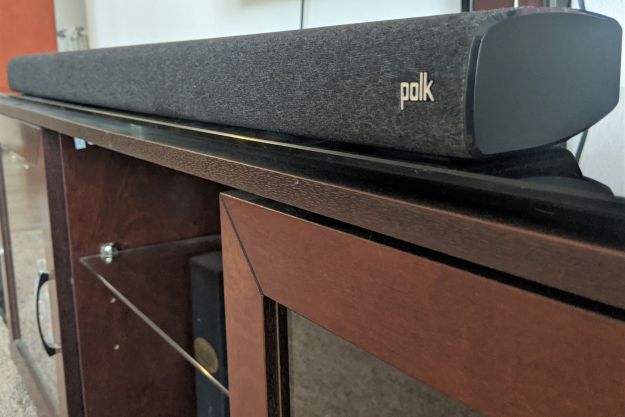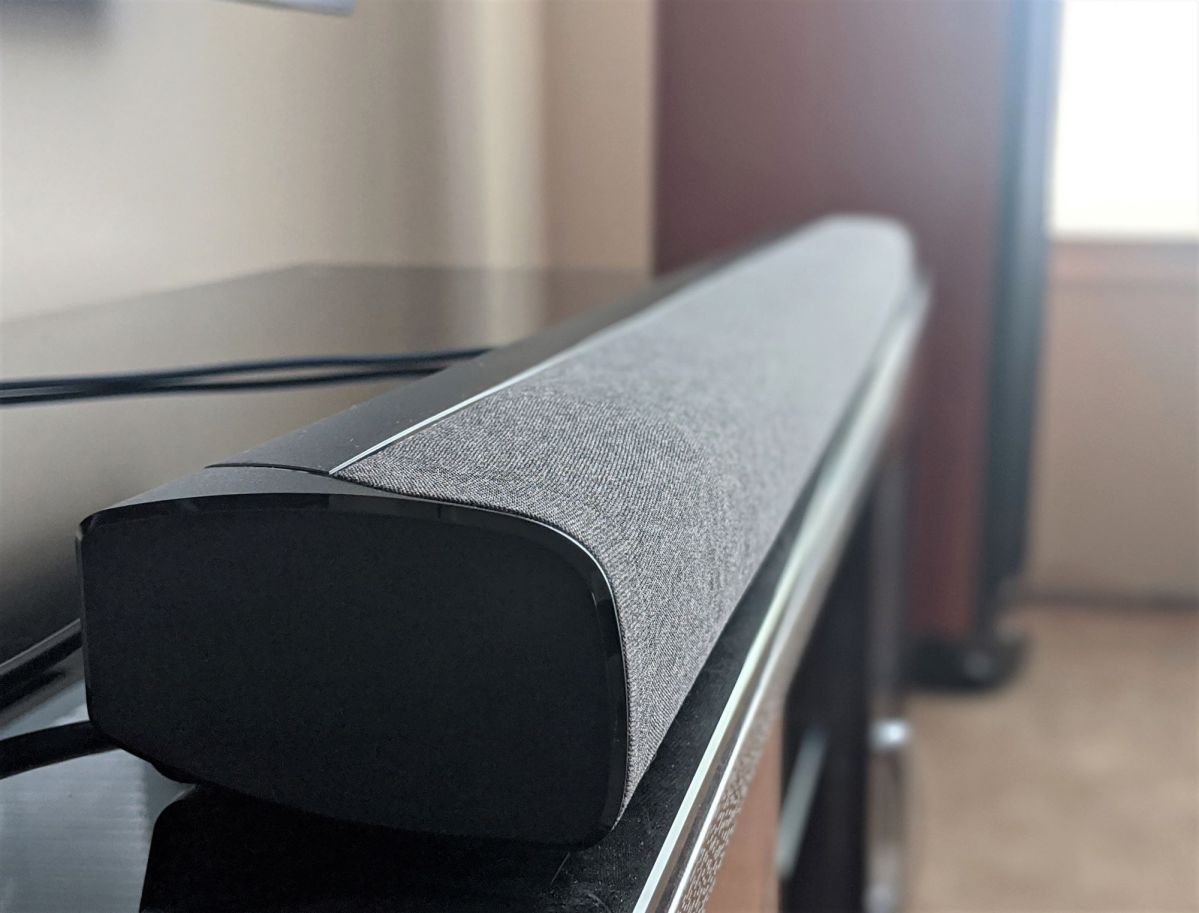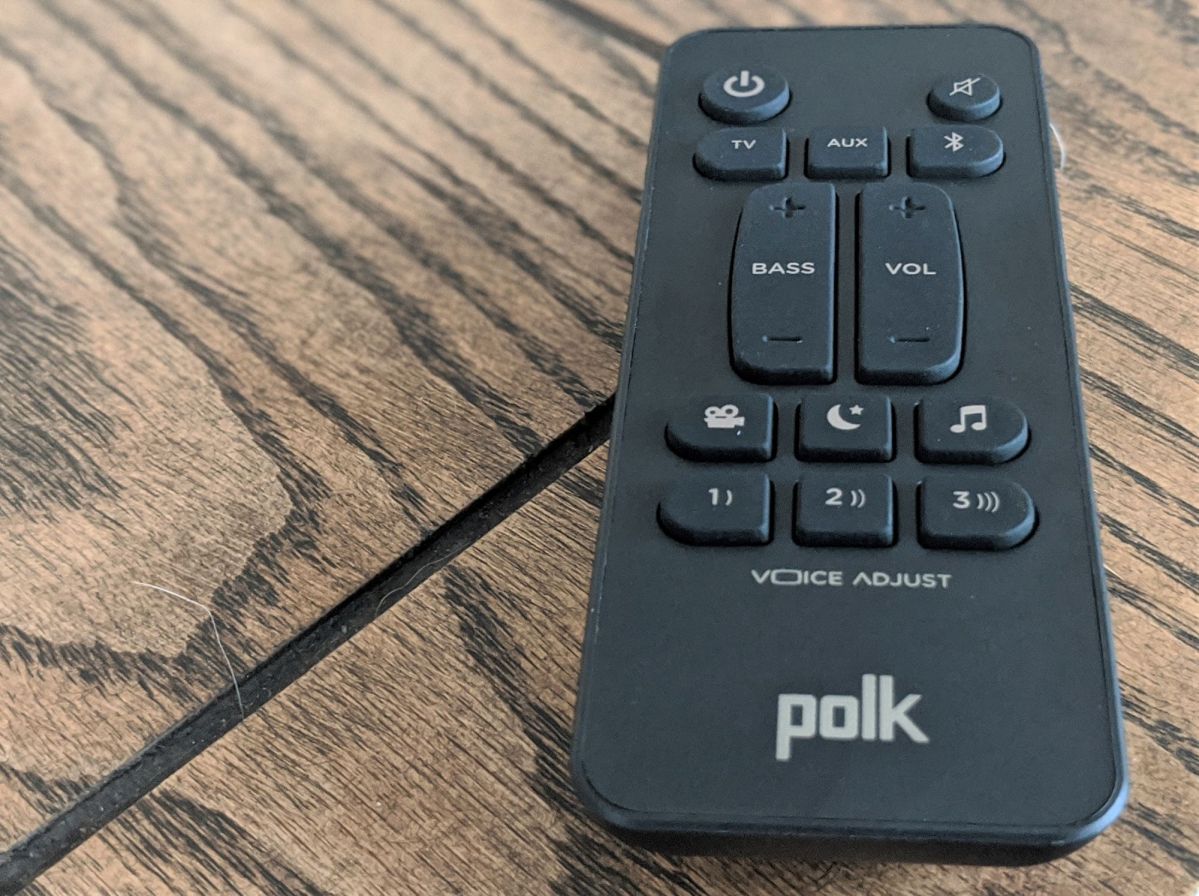
“Polk's quality Signa S3 soundbar gets a lot right, but lacks important features for the price.”
- Smooth design
- Quality stereo sound
- Wi-Fi connectivity
- Limited low end
- Missing surround sound
The soundbar marketplace is deceptively cutthroat. It doesn’t matter how good your features are or how great your sound is, if there is something slightly better for the same price, you’re going to be the odd bar out.
That’s the hard lesson Polk Audio’s new, $250 Signa S3 soundbar system is learning. It’s a solid option on its own, being a Wi-Fi-enabled soundbar with effective two-channel sound, but Polk just forgot about the budget behemoth waiting in the opposite corner of the ring. If you don’t know who we’re talking about, you’re about to.
Design
At various times in the past, both I and my co-workers at Digital Trends have heaped praise on the soundbars that are able to be heard, but not seen. That is, the bars that boast a design that doesn’t stick out, and blends into the room well enough to the point that you wouldn’t know it was there if it wasn’t blasting sound out toward you — the Bose Soundbar 700 is a great example of success here.

Soundbars from Vizio, LG, Samsung, and the like have all achieved that to one degree or another in the past. And I’d argue the Polk Signa S3 probably slots right into that category as well, and there is something about the aesthetic in this particular soundbar that appeals to me more than, say, the Vizio counterpart. One notable point is that the color and shape of this bar seems less harsh by comparison. The Vizio V Series is a black, brick-shaped bar with a grille that was slightly less black. The Polk, meanwhile, seems softer and more palatable with a lighter, more gray-colored grille that plays off the otherwise black bar well. That color is paired with a more rounded shape without all the sharp edges, which I also liked.
The Signa S3 sits at just over two inches tall and about 35 inches wide, which measures closely with competitors like the Vizio V Series. Inside the 2.1 channel bar are two pairs of tweeters and midrange drivers. For comparison purposes, the Vizio has a dedicated driver for the center channel of its 5.1 configuration. One driver may not seem like a huge difference, but as we’ll get to, this particular driver is a crucial one.
The wireless subwoofer for the Signa S3 is front-ported and follows the footprint of soundbar woofers like the LG SN7Y. They’re so similar in size, in fact, that it took a week for my significant other to release the sub in the corner of the room was a different one than had been there a week earlier. That gave me some initial concern since the subwoofer for the SN7Y did not impress me with its output. More on that in a moment.
The remote for the Signa S3 may feel somewhat cheap to the touch, but it’s conveniently on the smaller side and fits nicely in your hand. The Signa S3 supports Polk’s AnyRemote technology, meaning it should automatically respond to the IR signals of most TVs it’s connected to. According to Polk’s website, the Signa S3 will seamlessly work with Samsung, LG, Vizio, TCL, and Sony TV remotes for volume control, plus most CEC-enabled TVs.
Setup
The Signa S3 has a book report-sized quickstart guide that accommodates it, and I strongly suggest you do your homework on this one. Take it from someone who, for years, was too stubborn to read manuals: Setting aside the pride and letting the included paperwork guide you through the soundbar’s setup will make things infinitely simpler.

It starts like any typical soundbar: Connect your soundbar to your TV, plug both the bar and the subwoofer into power, pop the included AAA battery into your remote, and power everything on. The subwoofer should automatically connect to the bar, and the entire system should be playback-ready within a matter of moments.
Unlike some competing bars where the input that the soundbar is connected to is literally spelled out for you… the Signa S3 communicates this to you through a horizontal row of LED lights.
That all went smoothly for me, but the next steps did give me some pause. Unlike some competing bars where the input that the soundbar is connected to is literally spelled out for you — the aforementioned LG SN7Y comes to mind — the Signa S3 communicates this to you through a horizontal row of LED lights. Some make sense (a single blue light indicates that the bar is in Bluetooth mode), but it gets confusing beyond that. Luckily, the quickstart guide breaks it down for you, acting as a translator for the foreign language of lights that the S3 is speaking to you.
The guide also directs you to the Google Home app for connecting the Signa S3 to Wi-Fi, which is a gratefully easy process. It is a smooth transition from the guide to the Home app since the app takes you through adding your network and optimizing your bar at a step-by-step pace. I didn’t have the wherewithal to try it at the time, but I’m confident a far less tech-savvy person could have this system completely set up within 15 minutes. That’s the mark of a good, easy-to-use soundbar in my opinion.
Connections
Even by soundbar standards, the Signa S3 keeps things limited when it comes to connections. There’s a single HDMI ARC port, a digital optical port, and an auxiliary input. For context, the Vizio V Series adds a 3.5mm stereo audio input into the mix, as well as a USB port. I’ve gone on record before saying most soundbars need additional connections, and I stand by that. But this is, after all, a budget $250 soundbar. More HDMI ports would have been great, but at this price, it’s not quite a deal-breaker.

Here’s where I think the Signa S3 becomes a great value, at least in terms of connections. Unlike far more expensive bars like the LG SN7Y and the Sony HT-G700, this Polk Bar has Wi-Fi built-in. For my money, that’s huge, since it opens a world of possibilities. Because of it, the bar has Google Chromecast built-in, with options for streaming Google Play Music, Spotify, and plenty of other services straight to the bar. Additionally, you can use a Google Assistant-equipped device to control your music, and you can group your soundbar with other Chromecast-enabled speakers to create whole-house sound. Even more, your soundbar will be eligible to receive automatic software updates to continue improving the product over time.
This Polk Bar has Wi-Fi built-in. For my money, that’s huge, since it opens a world of possibilities.
The Signa S3 has Bluetooth connectivity available, too. But with the option of streaming of Wi-Fi and enjoying sound without dropouts or lapses in connection, I don’t know why you would ever choose the former over the latter. By outfitting its bar with Wi-Fi, Polk not only did what all soundbars — including the competing Vizio V Series — should do, but also what we believe there should be no excuse for not doing in 2020.
Sound quality
This is the make-or-break category for the Signa S3. For some, the stereo sound that it produces will be sufficiently enjoyable, and worth the price of admission. But for others hoping for a more immersive experience from their soundbar, they’ll likely want to look elsewhere.

The thing is, this really isn’t a controversial — or even debatable, really — statement. The Signa S3 is, after all, a 2.1-channel soundbar. It’s going to do better with audio that’s meant to be heard in stereo (i.e., music), and worse with content that benefits from a surround-sound setup (most TV shows and movies). Polk does get a little sneaky by saying it supports the Dolby Digital 5.1 sound format, which it technically does. It just can’t reproduce it since, again, it’s only a two-channel bar. Support does not equal performance here, so that language is irritatingly misleading.
For music, I found this bar to be stellar. Polk is a company that made its name in audio first after all, unlike the bigger brands like Vizio, Samsung, and LG. The company has a history of making music-friendly speakers, so it came as no surprise to me that the bar is capable of delightfully clear reproduction of tracks like Mumford & Sons’ Lover of the Light. As far as bass is concerned, the S3’s compact woofer handled short, punchy low notes effectively. But when asked to reach lower, or when the bass was increased via the bar’s remote, the sub succumbed to the limitations of its size and unfortunately sounded like it was stretching for a frequency it just couldn’t quite reach. If you don’t ask too much of it, you’ll be happy with this subwoofer — you just must be cognizant of what it can and can’t do.
When you try and squeeze five (or more) channels into two, the result is just not going to turn out the way it’s supposed to.
I want to be as clear as I can with this soundbar with regards to watching movies or TV shows: Objectively, it is an instant and significant improvement over standard TV speakers and gets you far closer to the way this content was intended to be heard. The clarity I mentioned when discussing music is still there, and the sub adds a modest rumble to your listening experience.
But, for the third and likely not last time, it’s a numbers game. When you try and squeeze five (or more) channels into two, the result is just not going to turn out the way it’s supposed to. In this regard, I’ll take the immersion of the Vizio V Series’ 5.1 setup or the impact of Dolby Atmos with the LG SN7Y’s 3.1.2 configuration, albeit for a considerably higher price. Maybe I’m just too used to having sound above or behind me, but my go-to test selections (Mad Max: Fury Road, John Wick, A Quiet Place) just weren’t the same audio spectacles I’ve come to know them to be on the Signa S3.
The Signa S3 does have three sound modes to help customize your audio: Movie Mode “enhances audio reproduction in TV and movies,” according to Polk; Night Mode dampens bass and dynamic sounds to keep the neighbors at bay; and Music Mode is, well, meant for music. These all work insofar that they’re the best presets for each situation but don’t expect them to be game-changing modes that will dramatically alter the audio reproduction. The same goes for Polk’s Voice Adjust feature, which lets you toggle between three different levels of voice enhancement. It’s helpful, but not as helpful as a dedicated center channel would be.
Our take
The Polk Signa S3 is a 2.1-channel soundbar that does what it’s designed to do remarkably well. That is, the bar takes the audio provided to it and creates a fun listening experience that’s exponentially better than anything standard TV speakers could produce. The problem is its value is damaged by competitors that bring more to the table without greatly impacting cost. A year ago, having surround sound at this price point might not have mattered as much. But the bar (no pun intended) has been raised, and an otherwise good system is overshadowed because of it.
Is there a better alternative?
The $250 Vizio V Series gives you a 5.1 experience for the same price making it a better option for movie night, though I’d still prefer the sound of the Signa S3 when it comes to stereo music. The $350 Yamaha YAS-209 is a more advanced alternative to the Polk, with Amazon Alexa built into the bar and compatibility with DTS: Virtual X. But like the Signa S3, does not have true surround sound.
How long will it last?
Polk has a two-year warranty on this bar, which also happens to be a well-made product. With the bonus of software updates, this bar should be able to be a fixture underneath your TV.
Should you buy it?
I think it depends on your use case. The Polk Audio Signa S3 has a lot going for it, including built-in Wi-Fi and exceptional stereo sound. If you were planning on using a soundbar for more than just movies, and were planning on throwing a healthy dose of music its way, I wouldn’t hesitate to suggest the Signa S3. But I think most folks value surround sound over streaming music capability, making the Vizio V Series a better option for the average consumer. In other words, Vizio, the value king, wins by a tough decision.
Editors' Recommendations
- LG’s 2022 soundbars start at $400, pump out hi-res audio and 3D sound
- Polk Audio’s new MagniFi 2 soundbar features immersive sound tech




